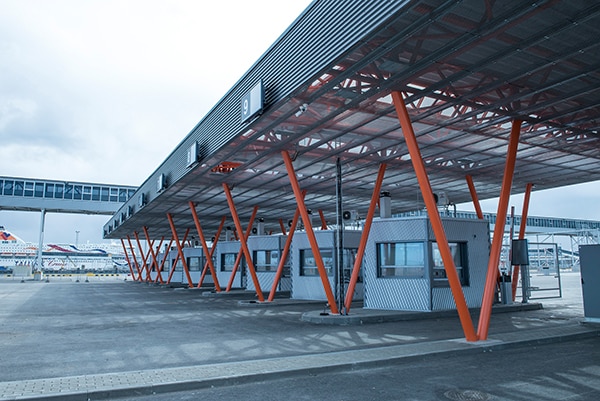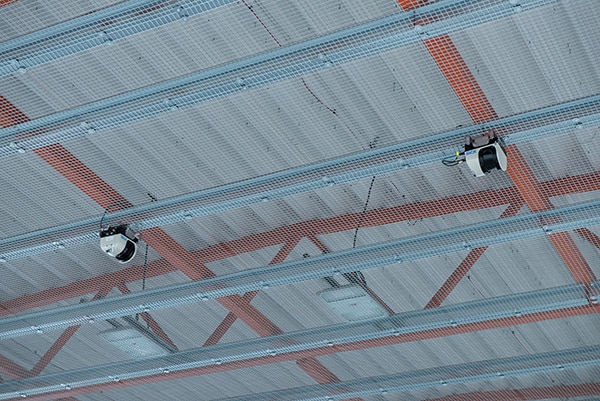The Old City Harbor of Tallinn is one of the busiest on the Baltic Sea. The wish to control the steadily increasing traffic volume and to improve the experience for passengers has prompted the port operator Port of Tallinn to install an automated traffic management system that includes SICK components.

Millions of passengers in the city center
The statistics describing traffic at the Port of Tallinn in 2016 are impressive: more than 10 million passengers, more than 20 million tons of cargo, more than 5,500 passenger ship dockings and visits from almost 300 cruise ships. However, the location – near the center of the city of Tallinn, poses some challenges for the Old City Harbor: Space is limited and expansion is impossible, an increasing number of passengers are travelling with their cars, the trucks also need a lot of space. The ever-larger vessels have to transport an increasing number of vehicles: The vessels have high drive-through decks on the dock level for trucks, and various low and medium-high decks for cars, vans and cars with roof loads. Loading of vehicles must be quick, in the right order, and in the right place.
In the past, each of the four shipping companies operating here had their own check-in booths. Because of the limited space and personnel, each operator has only had a couple of booths – so waiting times for check-in have often been very long. After check-in, the vehicles have been guided to various queues leading to right location on the vessel. A large number of staff clothed in yellow overalls have provided guidance and made sure that each vehicle is in the right place.
A unique traffic management system
The Smart Port Project of the Old City Harbor of Tallinn is a result of cooperation between many parties and is the first of its kind on the Baltic Sea. The Tallinn-based Hansab Group has been responsible for all activities in the dock area: For vehicle identification, the guiding system, and the gates and booms managing the traffic. SICK has provided the Free Flow Profiler, an automated measuring system for vehicle dimensions based on 2D LiDAR sensors for identifying the height, width and length of vehicles.

“We collect traffic data coming into the harbor and send it to the harbor’s system for processing,” explains Priit Ivanov. “The higher-ranking system determines how to treat each vehicle and returns the data to us. Then we show instructions for each vehicle on the signage boards and open the necessary gates to the waiting area. The whole operation takes less than one second for the instructions to be placed on the boards.”
Acceleration of the traffic flow
The renewal of the traffic management system started with the aim of providing a better experience and shorter waiting times for passengers. The check-in process was automated as far as possible, and the operator-specific check-in booths were transformed for mutual use. It is also now possible to use an online check-in function.

Now the cars drive into the area, their number plates are read by a camera, and the height, width and length of the vehicles are measured with the Free Flow Profiler based on 2D LiDAR sensors. Precise measurement of the vehicles ensures that each car is guided to exactly the right queue according to the deck spaces available on each vessel. Measuring also makes it possible to calculate in advance the use of each lane in the waiting area. Number plate identification ensures that the right car is in the right place and clear signage boards reduce potential mistakes.
The trucks drive in via their own lane, where they are also weighed and pre-checked. If the owner of an arriving car has checked-in in advance on the web, and the registration plate and dimensions comply with the information previously provided, the vehicle is allowed directly to the waiting area via a ’fast lane’. If not, the incomer is guided to the check-in booth.

“Check-in is now much quicker than before because it is done in advance or at one of up to eight parallel check-in booths,” explains Hele-Mai Metsal, Head of Infrastructure Development Department, Port of Tallinn. “If booths are not in use, they serve as ’fast lanes’ with number plate identification. In any case, the key to a quick check-in process is speed and efficiency in exchanging information when the booking data is compared with the actual data, and the result is sent to the check-in booth.” All this means that the cars can come to the harbor later than before and the waiting times are shorter. For the harbor, the new system means more efficient use of dock space, faster loading, and more efficient use of check-in areas. The system helps to arrange the vehicles in the right order for loading, and thus cuts the time spent at the harbor. This enables greater utilization of the vessels. And because the cars wait for a shorter time, their engines are also left idling for shorter periods, reducing the environmental impact.



